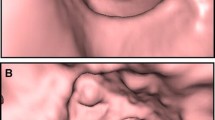Abstract
INTRODUCTION: It is generally accepted that clinicians performing colonoscopy should reach the cecum in at least 90 percent of examinations. However, little attention has been paid to whether the endoscopist correctly estimates the amount of colon actually seen. METHODS: During colonoscopy, endoscopists were asked to state how far they had reached. This was compared with the amount of colon actually seen, as assessed by a novel electromagnetic imaging device that recorded a three-dimensional position of the scope within a magnetic field pervading the patient's abdomen. If electromagnetic imaging showed that the cecum had not been reached, the endoscopist was asked to use the electromagnetic imaging system to determine whether it helped advance the colonoscope further. RESULTS: In 119 patients undergoing colonoscopy, clinical assessment of position reached was correct in only 92 (77.3 percent). When the endoscopists stated that cecal landmarks had been seen (n=85), the scope was distal to the cecum in seven cases (8.2 percent). When cecal landmarks had not been seen (n=34), the endoscopist's assessment of the position of the scope was accurate in only 14 (41.2 percent). The use of electromagnetic imaging in this latter group assisted passage to the cecum in 26 cases (76.5 percent). CONCLUSION: Despite assumed visualization of the cecum, inadequate colonoscopy highlights the potential for missing significant pathology in the right colon.
Similar content being viewed by others
References
Schrock TR. Colonoscopy versus barium enema in the diagnosis of colorectal cancers and polyps. Gastrointest Endosc Clin North Am 1993;3:585–610.
Miller R, Lehman G. Polypoid colonic lesions undetected by endoscopy. Radiology 1978;129:295–7.
Miller BJ, Cohen JR, Theile DE, Schache DJ, Ku JK. Diagnostic failure in colonoscopies for malignant disease. Aust NZ J Surg 1998;68:331–3.
Rex DK, Rahmani EY, Haseman JH, Lemmel GT, Kaster S, Buckley JS. Relative sensitivity of colonoscopy and barium enema for detection of colorectal cancer in clinical practice. Gastroenterology 1997;112:17–23.
Baillie J, Ravich WJ. On endoscopic training and procedural competence. Ann Intern Med 1993;118:73–4.
Winawer SJ, Fletcher RH, Miller L,et al. Colorectal cancer screening: clinical guidelines and rationale. Gastroenterology 1997;112:594–642.
Hoff G, Foertser A, Vatn MN, Sauer J, Larsen S. Epidemiology of polyps in the rectum and colon: recovery and evaluation of unresected polyps 2 years after detection. Scand J Gastroenterol 1986;21:853–62.
Hixon LJ, Femerty MB, Sampliner RE, McGee D, Garewal H. Prospective study of the frequency and size distribution of polyps missed by colonoscopy. J Natl Cancer Inst 1990;82:1769–72.
Anderson ML, Heigh RI, McCoy GA,et al. Accuracy of assessment of the extent of examination by experienced colonoscopists. Gastrointest Endosc 1992;38:560–3.
Marshall JB, Brown DN. Photodocumentation of total colonoscopy: how successful are endoscopists? Do reviewers agree? Gastrointest Endosc 1996;44:243–8.
Bladen JS, Anderson AP, Bell GD, Rameh B, Evans B, Heatley DJT. Non-radiological technique for three-dimensional imaging of endoscopes. Lancet 1993;341:719–22.
Landis JR, Koch GG. Measurement of observer agreement of categorical data. Biometrics 1977;33:159–74.
Cirocco WC, Ruslin LC. Documenting the use of fluoroscopy during colonoscopic examination: a prospective study. Surg Endosc 1991;5:200–3.
Expert Advisory Group of the Royal College of Surgeons of England and the Association of Coloproctology of Great Britain and Ireland. Guidelines for the Management of Colorectal Cancer. London, UK: Royal College of Surgeons of England, 1996:15–6.
Haseman JH, Lemmel GT, Rahmani EY, Rex DK. Failure of colonoscopy to detect colorectal cancer: evaluation of 47 cases in 20 hospitals. Gastrointest Endosc 1997;45:451–5.
Cirocco WC, Rusin LC. Confirmation of cecal intubation during colonoscopy. Dis Colon Rectum 1995;38:402–6.
Vignati P, Welsh JP, Cohen JL. Endoscopic localisation of colon cancers. Surg Endosc 1994;8:1085–7.
Saunders BP, Bell GD, Williams CB, Bladen JS, Anderson AP. First clinical results with a real time, electronic imager as an aid to colonoscopy. Gut 1995;36:913–7.
Parry BR, Williams SM. Competency and the colonoscopist: a learning curve. Aust NZ J Surg 1991;61:419–22.
Author information
Authors and Affiliations
Additional information
The electromagnetic imaging system used in this study was donated by the University Department of Electronics, University of Sheffield, United Kingdom.
Presented in part or in full at the British Society of Gastroenterology Meeting, Harrogate, United Kingdom, March 10, 1998; the Royal Society of Medicine Section of Coloproctology Meeting, Grenoble, France, April 15, 1998; and the Tripartite Meeting, Washington, DC, May 4, 1999.
About this article
Cite this article
Adam, I.J., Ali, Z. & Shorthouse, A.J. Inadequacy of colonoscopy revealed by three-dimensional electromagnetic imaging. Dis Colon Rectum 44, 978–983 (2001). https://doi.org/10.1007/BF02235486
Issue Date:
DOI: https://doi.org/10.1007/BF02235486




